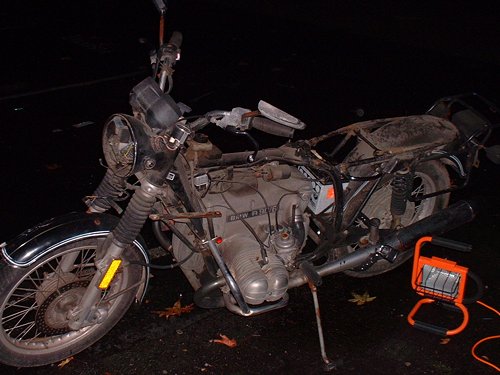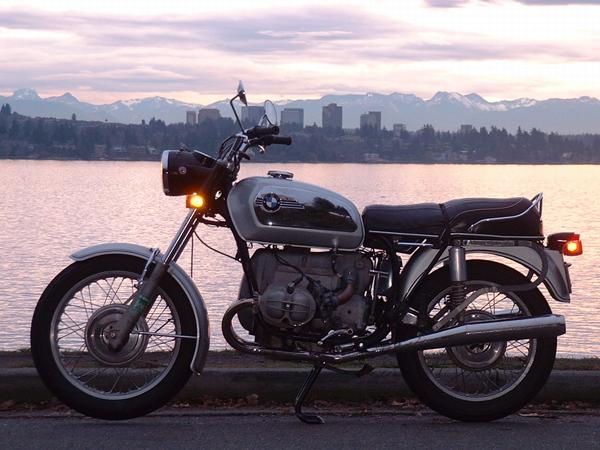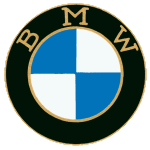www.bynumonline.com
Christian Bynum's Classic BMW Motorcycles: Do-It-Yourself Painting Tips
Home > Motorcycles > Technical > DIY Painting Tips


Whenever I can afford it, I go with a professional paint job on my bikes, including hand pinstriping; a top-notch pro finish is the eventual goal for every restoration ride in my stable.
However, during my "ride-as-I-restore" process, I have forayed into do-it-yourself economy bodywork refurbishment for Airheads with passable results for my fenders and sidecovers. I had no significant prior experience and did not have the best tools or working conditions, but I still managed to achieved fairly presentable results the first time around using decent-quality automotive enamel paints and clearcoats.
As you evaluate the pros and cons of doing your own motorcycle painting, consider that, as expensive as a pro paint job can be, if you remember to factor in the value of your own time as well as the more concrete costs of materials, you may find that there is actually a false economy to DIY. But if you're willing to chalk your time expenditures up as "valid recreational pursuits" while you paint, you can save a little money and have a nicely refurbished motorcycle.
That said, here are my tips and recommendations for cheap and efficient "rattlecanning" based upon my initial experiences painting BMW motorcycle bodywork:- Don't skimp on paint. Plan on layering at least 3-4 coats of sandable primer or primer/sealer, 3-5 enamel color coats, and 4-6 clearcoat layers, depending on how successful you are as the process progresses. That's no less than ten layers of paint.
- For cheap DIY jobs, keep it your color simple. Gloss black enamel (comparable to the original factory Glasurit Avus Black) is readily, hides flaws surprisingly well, easily matched, and looks classy on Beemers, whether you decide to pinstripe or not. Other solid colors (especially white) can also be made to look good with relative ease. Avoid metallics and two-tone appications for your first try.
- Try to keep your work area clean. It can be hard for the amateur painter to find a work area that is both well ventilated and dust-free. Your painted bodywork needs to be sprayed and allowed to dry where dust, dirt, and debris are minimized until the wet paint is dry. Sheets of plastic (e.g., 1- to 3-mil plastic dropcloths) can help control airborne foreign matter as well as catch overspray from the painting process.
- Temperature is important to the quality of your finish. Warm your cans in a warm (not hot) water bath to bring the propellant up to a useful temperature for smoothest application. Don't paint or let the parts you are painting dry in a location that's either too hot or too cold.
- Sanding is critical to getting your best posible results, and it should be done with great care. Have the following wet/dry grits available: 220, 400, 600, 1000, 1500, and 2000. Sand carefully, minding small contours that can cause you to sand unevenly.
- Start by prepping the surface of the bodywork by sanding it smooth, making repairs and working up in grit to 400 or 600.
- Apply your first coat of primer. Build up your first coat gently, but apply enough paint to begin to hide the imperfections on the raw surface.
- Don't rush at any point in the process, whether you are painting or waiting for a coat to dry and cure. When thoroughly dry and hardened, sand the primed surface gently and then add slowly another coat, repeating the process as above until the requisite number of coats have been deposited and the minor imperfections of the unprimed surface have disappeared.
- Do not sand between the final layer of primer and the first color coat; this promotes adhesion.
- As you apply the color coats a layer at a time, continue to build them up slowly using full-length strokes. Keep the can moving and shake it frequently. Remember to overspray your bodywork, starting to spray before your get to the leading edge and continuing to spray until you're off the trailing edge, in order to avoid terminal accumulations that are too thick. As you apply the color, you may find that crosshatching directions of motion for your spraying will give good, even coverage that is smooth and uniform. Lighter is better!
- Allow the color coats to cure completely (for hours or even days) before sanding and adding the next coat. Sand your color coats gently, first with wet 1000 or 1500 grit paper on the first enamel color layer and up to 2000 on the final one. Use plenty of water, and feel for any of the characteristic "orange peel" surface between sandings until none is detected.
- Again, between the final layer and the first clearcoat layer, do not sand; this will promote adhesion between the layers.
- With the clearcoats, use the same techniques as for the color layers, being even more careful to sand the surface smooth without "burning through" it to a lower layer, which can cause a faint, ghostly ring of "interlaminar discontinuity" on the surface that can be difficult to remove later. As you build up the smooth clearcoat layers, the shine and patina will start to deepen.
- If you are using tape to pinstripe your tank, apply it according to instructions and allow the surface underneath to dry and harden completely before you proceed. Once the tape stripes are in place and well bonded (usualy a full day), I have had good results burying them under two additional clearcoats. Use 2000 grit wet sandpaper, and sand very gingerly at the edge of the stripes.
- Once all the color and clearcoat layers have been deposited, use a lambswool pad and rubbing or finishing compound to do the coarsest buffing, eventually working your way down to hand buffing with terry or foam. (I prefer the latter.) This is what really brings out the shine and lends depth to the finish. Then wax it and you're done!
There are undoubtedly many improvements that can be made to these basic techniques, but the information above is enough to get you started thinking about the DIY painting process for your Airhead restoration project.




